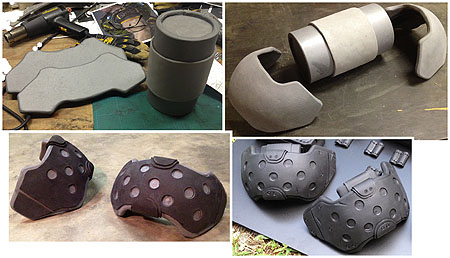introduction to EVA Foam Armor Crafting
Assembling the Armor
Here are the pieces for the Garron Paduk boots. They have been cut out using an X-acto knife. The sharpie tick marks are to help me match up the pieces and to mark locations for seam lines, center line, etc.
The next step for them will be to flatten the texture by heating the surface with a heat gun. After the texture has been removed, you can start to heat the EVA foam for shaping. Keep the heat gun about 2"-3" away from the foam, and keep the gun constantly moving. You don't want to heat it up too much. If you do, you'll end up with a burned/scorched spot. |
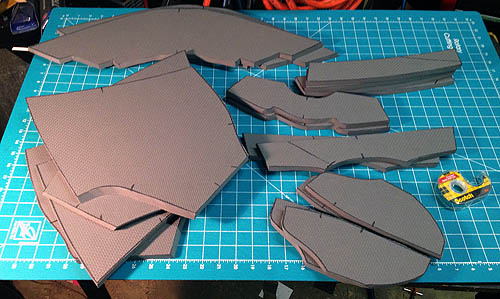
|
I only use superglue for assembling my EVA armor. I know some people use hot glue & other adhesives, but I've found that my coating/painting aheres better if hot glue is not involved. Bill Doran of Punished Props did a video on his YouTube channel about the various super glues he uses for his props. I couldn't say it any better, so instead of trying, here's his video. |
|
These are the boot tops on my Marcus Fenix boots. I placed them on the MF boots because I hadn't completed Garron's boots yet. (the boots were on back order) You can see that there's a fairly sharp bend in the front of the boot top. This was achieved by grinding out 1/4" deep channel in the back side of the foam. |
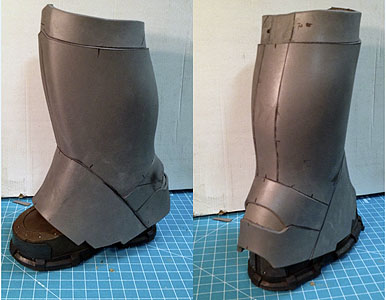
|
| This is the Doc Marten boot with the EVA shell applied. The boot & boot upper will not be glued together. I attached an elastic strap to the pull loop of the boot & velcroed it up high inside the boot top. The elastic was able to stretch when I walked, and pulled the boot top back down when I wasn't walking. | 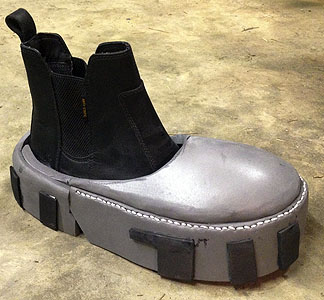
|
Here are the main panel lines cut into the boot top. I used the sharpie tick marks that I made earlier as a guide. Just take your metal ruler & mark the line with a sharpie. Then use the side of a Dremel 85422 Silicon Carbide Grinding Stone |
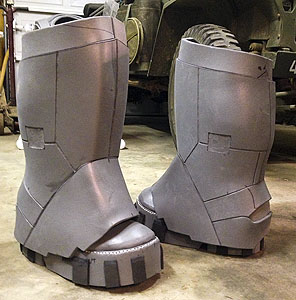
|
This shows the addition of the kneepads to the boot. As you can see, the kneepad is made from two halves, that are heat formed & then glued together. I could have made this from a single piece, but the model shows a seam there, and making it in two halves allowed me to replicate the shape of the curve accurately for the two kneepads. Otherwise it would have been trial & error to match the curve of the two kneepads. |

|
Now I'm applying details made from 2mm & 3mm fun foam (Silly Winks). The large pieces are cut & then applied to the boot using superglue. I did not cut the slots into the kneepad inset until after I had glued the piece down. I did a plunge cut with the end of a dremel chainsaw sharpening stone to drill each end of the slot, then went back with the same bit to connect the two holes. I used the same process for the slots cut into the face of the boot top just below the kneepads. |
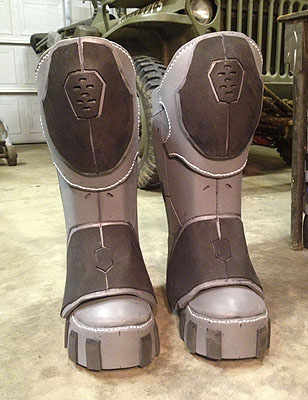
|
Here's the boots just about done. It still need keepers to hide the seam between the kneepad & straps, but it's just about ready for Plastidip. To find out more about simulating the stitching visit THIS PAGE. |
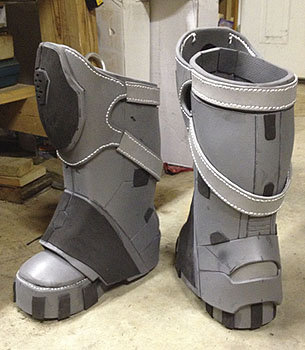
|
More Assembly Photos and Information
| <-Back to Cutting & Shaping the EVA Foam | On to Plastidipping and Painting the Armor-> |

